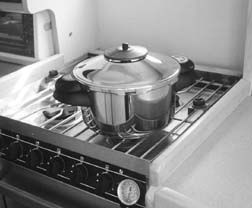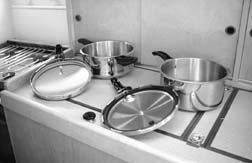Mention the words “pressure cooker” and nearly every cook can volunteer a tale of woe. Steven King’s novels hold no terror for cooks who have lived through an episode of exploding cookers or baked beans flying out of the hole formerly occupied by an improperly tightened pressure regulator.

Yet pressure cookers are the greatest galley gadget for small boats. In fact, Michael Greenwald, author of The Cruising Chef Cookbook, says if you only have room for one pot, make it a pressure cooker. He considers a 6-quart pot essential.
Today’s pressure cookers, most touting triple safety valves, are a far cry from yesteryear’s pots of doom.
Invented in 1680 by a French inventor, Denis Papin, and popularized by Napoleon’s armies in the early 1800s, the early cookers were more valuable as canning devices used to prevent contamination and prevent food spoilage. In 1938, the large commercial canning cookers were adapted to home use as the pressure saucepan.
These microwaves of the ‘40s were popular during and after WWII when women joined the work force but still had to prepare meals without the aid of fast food and TV dinners. In Europe and India, the scarcity of cooking fuel made them essential. The invention of the microwave virtually eliminated any advances in pressure cooker development until recently, when the cookers regained stature as a means to healthful cooking.
It is not for Practical Sailor to launch a discussion of the pros and cons of pressure cooking as it relates to nutrition. Suffice it to say that pressure cookers reduce cooking time—and thus fuel consumption—by 50% to 90%. By containing steam and building pressure inside the pot, the boiling temperature of the liquid in the pot raises from 212°F to 227°F at 5 pounds pressure up to 250°F at 15 pounds pressure, the maximum pressure for which any cooker is rated. Pressure cooking also reduces the amount of water or liquid needed for cooking, another plus for the self-sufficient cruiser.
Not All Cookers Are Equal
Pressure cookers in production today fall into one of four types: jiggle-top, fixed weight, spring valve, and electric. The jiggle top is the common variety of decades-old technology. A weight on the steam vent pipe begins bouncing or swinging when pressure is reached, indicating it is time to turn down the heat under the pot. Instructions can be somewhat cryptic as this from Presto: “Once the pressure regulator attains a gentle rocking motion gradually lower the heat as necessary to maintain a slow steady rocking motion and cook for the length of time indicated in the recipe or cooking chart.”
Unless you are very lucky, your first trial-and-error experience will likely end up with an error and over-cooked food. If you are very unlucky, you’ll mistake the steam vent samba for slow rocking motion and too much steam will escape, all the liquid will evaporate and your food and the pan will scorch. Because these cookers do not have a built-in expansion disk on the bottom of the pot, they cannot be used on flat, smooth-top cooking surfaces.
Fixed weight cookers are sometimes called second generation cookers. Well-known manufacturers include Fagor (Spain), T-Fal (France) and Presto (US). This type uses a weight valve that is either fixed on the vent pipe by the manufacturer or locked in place by the user. When cooking pressure is reached in the pan, the valve raises up slightly, emitting steam to indicate it is time to lower heat to the point that just a faint wisp of steam and a slight hissing sound remains. Obviously, lighting in the galley and engine noise might make this type of cooker’s audio/visual signals less than helpful, but once you establish the proper heat setting for your stove, the cues will be less important.

Spring valve cookers are the third generation and in non-electric cookers present the state-of-the-art. Among the well-known manufacturers, this type of cooker is made by Kuhn Rikon (Swiss), Fagor Megafasa (Spain), and Lagostina (Italy). When pressure is achieved in the pot, a spring-loaded valve raises an indicator. Some models display high and low pressure settings and other allow you to dial your own preference. These designs tend to vent the least steam.
Electric cookers are new to the market and are made by Revere Electronics and Maxim (US). They reach and maintain pressure automatically, some at high only, and some can be programmed for timed start. They come in four- and six-quart sizes only. Because there are no visual signals with this type of cooker, adapting recipes may take some effort. Express Cooking by Barry Bluestein and Kevin Morrissey gives conversion information.
Putting Types to the Test
Because electric pressure cookers seem antithetical to small boat cruising, we did not include them in the test. We also did not include any aluminum cookers at the insistence of the tester who threw out all her aluminum pots when the research began showing a link between aluminum salts in the environment and Alzheimer’s disease. We chose 4-quart pots for their representation in the Georgetown, Bahamas survey (see sidebar), for their good pot-bottom (8-3/4″) to burner-size ratio, manageable size, and suitability to a cruising couple. Note: Those who intend to can, make bread or steam deserts in their cookers will probably want a taller model. The cookers evaluated represent a wide price range and all pressure indicator types.
How The Test Was Done
In each experiment, seven whole red potatoes were placed on the bottom of the cooker. Regardless of the cooker and the potatoes, seven potatoes would always fill the bottom. According to instructions, 2 cups of water were poured in with the potatoes. (Because 2 cups of water in no way covered the potatoes, as you would expect with normal cooking, we added a third cup of water to the pot before locking the lid in place. This bit of ad-libbing was rewarded with an inordinate time to pressure and with lots of sputtering and steaming by the cooker, in this case the Presto jiggle-top. As the troubleshooting section DOES say that the likely cause of such sputtering is too much liquid, the experiment was repeated with 2 cups of water.)
The cookers were all heated on the same burner on an electric stove at the same setting, one notch below high heat. Time to pressure was recorded along with the manufacturers’ suggested cooking time. When done, all pots were cooled by the quick-release method (running cold tap water over the lid for one to two minutes until pressure indicators indicated it is safe to open the lid).
Bottom Line
You don’t always get what you pay for. The Presto cooker, which was priced in the middle of our three new cookers, was our family’s least favorite. Its single handle made the pot difficult to carry to the stove when loaded with potatoes and water. This would be a definite drawback for those with arthritis or weak wrists. The top felt light and tinny and was the most difficult of the three to align properly. It does not have a handy fill line stamped in the pot. The Presto 6-quart stainless steel model does have a second handle. We have seen this model in discount stores for $59.99, but the sole package had been opened and the lid had been forced on incorrectly, so we did not buy it for fear of a damaged gasket. The Presto 8-quart anodized aluminum model has two handles and claims to hold five pint-size canning jars. We saw it advertised for $68.88 at a discount store.
The Fagor Rapida was certainly acceptable, but it seemed silly that the stainless steel pot came with an aluminum trivet. Once you get the hang of “reading” the steam—the instruction booklet notes that actual cooking time begins “once a steady stream of steam begins to come out of the automatic vent. At this point lower heat to medium low to maintain a gentle, steady stream of steam.” This cooker has two handles and fill mark.
The Fagor instruction booklet was better instructionally than Presto’s but weak on cooking tables and recipes (six tables and 31 recipes to five tables and 60 recipes in Presto’s instructions). The Fagor book also had this helpful hint for cooking on electric burners: When the cooker begins to make bubbling noises, turn on a second burner to medium low heat. When the cooker reaches pressure, shift the pot to the lower temperature burner as electric burners are slow to cool. Otherwise the cooker tends to get over pressured.
The Fagor comes with a 10-year limited warranty (gaskets not included). We saw one 6.5-quart pot advertised with a video instruction booklet for $69.99 at a kitchen and bath-type store.
Everyone in our crew asked if we could keep the Kuhn Rikon Risotto cooker. Don’t let the name Risotto fool you—this cooker is not limited to rich rice dishes. It has the same 8-3/4″ diameter as the 5-liter pot. However, this cooker’s two short, round handles should make it easiest to store. The lower wall height (from the 5-liter pot) makes it easier to stir or fry in the pan. Lid lock was a breeze. It has a fill mark. Color indicators for low and high pressure took the guess work out of reading steam. We bought this one over the Internet from Cooking.com, which had discounted its price $10 from other net sources we found. Kuhn Rikon has an excellent web site with full information on it’s entire line plus lots of recipes, but it does not sell its own products on the site. Click to purchase and you will be shown a list of web retailers.
You can also get an 800 number to call for retailers in your area. We did and found that the local retailers did not have the cooker in stock. Our Internet order was delivered in three days.
While this was the most expensive cooker—a check of e-tailers showed it was in the same ballpark at the Lagostina used by some in the survey—the extensive 92-page pressure cooking guide and recipe book, plus the simple 12-page risotto recipe book, would save you the $20 or so you would otherwise need to spend on a decent collection of pressure cooker recipes to use until you figure out how to adapt every one in your memory or collection.
One more note on pressure cooker cookbooks, the Kuhn Rikon site recommends Lorna Sass’ books Cooking Under Pressure and Great Vegetarian Cooking Under Pressure.
If you intend to can or will routinely cook for four persons or more, the 4-quart pressure cookers will probably frustrate you. Buy a larger size. Pressure cookers should not be filled more than two-thirds full if cooking vegetables or half full if making grains or soup.
Contacts- Kuhn Rikon USA, 350 Bon Air Center, Suite 240, Greenbrae, CA 94904; 800/662-5882 ([email protected]). Fagor America, Inc., 1099 Wall Street West, Suite 349, Lyndhurst, NJ 07071; 800/207-0806. National Presto Industries, Inc., 3925 North Hastings Way, Eau Claire, WI 54703; 715/839-2209.

































